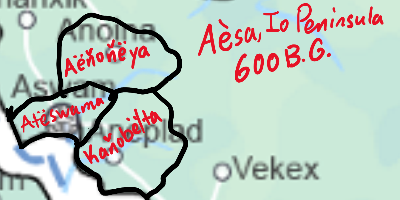Low Iopon (1 янв 730 г. – 1 янв 1000 г.)
Описание:
During the development of Low Iopon, the language began to split between Southern/Eteran Low Iopon and Northern/Eteshik Low Iopon due to the collapse of Iopon Empire. The sound changes noted below are regarding Eteran Low Iopon, however, the two hold similar evolutions with not much variability.Sound Changes between High Iopon and Low Iopon
Unstressed Vowel Syncope evolve into heavy consonant clusters:
Unstressed short vowels vanish much more often, even in two syllable words
Careful or formal speech require epenthesis (/ɑnə̆l/ instead of /ɑnl/), but colloquially is cluster-heavy
Exe. High: /ɑˈnɑlo/ > /ɑnə̆l/
Medial fricatives delete
Stops and voiced fricatives (/β, v, f, ɸ/) in the medial position reduce and often drop
Exe. Cl. Pillar = /kɑˈbɑtɑ/ > Mid. /kɑβɑθɑ/ > Low /kɑːθɑ/
Dipthong monopthongization completes
Remaining dipthongs smooth into long or tense monophthongs
/ɑɪ̯/ > /e/, /eɪ̯/ > /i/, /ɑ̯u/ > /o/
Palatization consolidation
Velars before front vowels or /j/ stabilize as /ʧ/ and /ʤ/ while palatization before /a/ spreads in some dialects
Exe. /kʲen/ > /ʧen/
Nasal assimilation and simplification
Nasal and stop clusters simplify
/nt/ > /n/ or /t/, /ᵑk/ > /ŋ/ or /k/ in fast speech
Formal or education may keep fuller forms; common in unstressed syllables
Cluster simplification
Most clusters simplify either by loss or epenthesis
/kt/ > /t/ or /k/; /tʃ/ > /ʃ/ or /ʧ/
Loss of final short vowels
Short vowels in final unstressed syllables are lost in most words, especially masculine -a endings and feminine -ea endings
Poetic speech preserves them for rhythm
Lenition in initial clusters
Some dialects weaken the first element of complex word onsets, primarily in Eteran Iopo
/pl/ > /fl/, /bl/ > /βl/ > /vl/, /gn/ > /nʲ/
Emergence of geminate consonants from assimilation
While geminates were lost earlier in the language's history, new ones potentially emerge where consonant loss created long consonants
/nn/, /ll/ in compounds while /tt/ > /ʧ/ and /ss/ > /ʃ/ or /ʒ/
Morphological and syntactic effects
Nominal system
Case endings almost gone with gender distinctions only surviving in pronouns and some common nouns
Most nouns, however, appear in a single uninflected form with relationships being marked by separate prepositions or verb prefixes
Verbal system
Preverb system fully grammatical into aspect/direction markers
Auxiliary verbs (descended from "to be", "to do", and "to go") carry tense and mood.
Agreement morphology on verbs is minimal; many forms are periphrastic
Word Order:
Fully SVO
Object pronouns appear after verb but before other complements
Examples
Battle:
Cl. /ˈki̯eta/ > Mid. /ˈʧeta/ > High /'teta/ > Low /tet/
World:
Cl. /ˈmeɣene̯ɑ/ > Mid. /meːni̯ə/ > /menə/ > Low /mɛn/
Vekex (Vekisa):
Cl. /veˈkisɑ/ > Mid. /vəkisə/ > High /vəkis/ > Low /veʧis/
To cook:
Cl. /tes|tɪk/ > Mid. /θes|θəɣ/ > High /θes|θə̆x/ > Low /θes/
Добавлено на ленту времени:
Дата:
1 янв 730 г.
1 янв 1000 г.
~ 270 years
